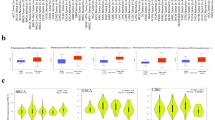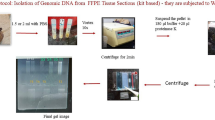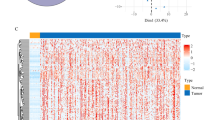Abstract
In view of recent studies highlighting the prognostic relevance of expression and CpG island methylator phenotype (CIMP) of Bcl-2/adenovirus E1B 19 kDa-interacting protein 3 (BNIP3) in invasive duct cell carcinoma (IDC), we hypothesized in this article that impaired one-carbon metabolism might influence CIMP phenotype of BNIP3. In order to substantiate the prognostic relevance of BNIP3, we explored its association with 8-oxo-2′deoxyguanosine (8-oxodG), a marker of oxidative stress with prognostic relevance. BNIP3 expression and CIMP phenotype were studied using semi-quantitative RT-PCR and combined bisulfite restriction analysis (COBRA), respectively, in 56 IDC tumors. Eight polymorphisms in one-carbon metabolism were studied using PCR–RFLP and PCR–AFLP approaches. 8-oxodG was measured using competitive ELISA kit. BNIP3 was found to be upregulated in IDC (cases vs. controls: 0.94 ± 0.05 vs. 0.18 ± 0.08, P < 0.0001). COBRA analysis confirmed hypomethylation of BNIP3 promoter CpG island in these cases. CIMP phenotype of BNIP3 showed positive association with tubule formation (P = 0.034) and methionine synthase reductase (MTRR) A66G (P = 0.002); inverse association with cytosolic serine hydroxyl methyltransferase (cSHMT) C1420T (P < 0.005) and 8-oxodG (<10% vs. >10% methylation: 7.24 ± 2.77 ng/ml vs. 4.42 ± 2.93 ng/ml, P < 0.0005); and no association with nuclear pleomorphism or mitotic index or ER, PR, and HER statuses. Synergistic effect of MTR A2756G and MTRR A66G variants on BNIP3 hypermethylator phenotype was clearly evident (P < 0.0007). MTRR A66G and cSHMT C1420T polymorphisms influence CIMP phenotype of BNIP3, thus epigenetically regulating BNIP3 in breast cancer. The linear association between BNIP3 and 8-oxodG substantiates the role of BNIP3 as redox sensor as well as prognostic marker in breast cancer.


Similar content being viewed by others
Abbreviations
- 8-oxodG:
-
8-Oxo-2′-deoxyguanosine
- AFLP:
-
Amplified fragment length polymorphism
- BNIP3:
-
Bcl-2/adenovirus E1B 19 kDa-interacting protein 3
- CIMP:
-
CpG island methylator phenotype
- COBRA:
-
Combined bisulfite restriction analysis
- cSHMT:
-
Cytosolic serine hydroxymethyltransferase
- DCIS:
-
Duct cell in situ
- DNMT:
-
DNA methyltransferases
- HIF-1:
-
Hypoxia inducible factor-1
- IDC:
-
Invasive duct cell carcinoma
- MTHFR:
-
Methylene tetrahydrofolate reductase
- RFLP:
-
Restriction fragment length polymorphism
- ROS:
-
Reactive oxygen species
- RT-PCR:
-
Reverse transcriptase PCR
- TYMS:
-
Thymidylate synthase
References
Reed JC (1998) Bcl-2 family proteins. Oncogene 17(25):3225–3236
Vande VC, Cizeau J, Dubik D, Alimonti J, Brown T, Israels S, Hakem R, Greenberg AH (2000) BNIP3 and genetic control of necrosis-like cell death through the mitochondrial permeability transition pore. Mol Cell Biol 20(15):5454–5468
Tan EY, Campo L, Han C, Turley H, Pezzella F, Gatter KC, Harris AL, Fox SB (2007) BNIP3 as a progression marker in primary human breast cancer; opposing functions in in situ versus invasive cancer. Clin Cancer Res 13(2 Pt 1):467–474
An HJ, Lee H, Paik SG (2011) Silencing of BNIP3 results from promoter methylation by DNA methyltransferase 1 induced by the mitogen-activated protein kinase pathway. Mol Cells [Epub ahead of print]
van Diest PJ, Suijkerbuijk KP, Koop EA, de Weger RA, van der Wall E (2010) Low levels of BNIP3 promoter hypermethylation in invasive breast cancer. Anal Cell Pathol (Amst) 33(3):175–176
Friso S, Choi SW (2002) Gene-nutrient interactions and DNA methylation. J Nutr 132(8 Suppl):2382S–2387S
Xu X, Chen J (2009) One-carbon metabolism and breast cancer: an epidemiological perspective. J Genet Genomics 36(4):203–214
Naushad SM, Pavani A, Digumarti RR, Gottumukkala SR, Kutala VK (2010) Epistatic interactions between loci of one-carbon metabolism modulate susceptibility to breast cancer. Mol Biol Rep [Epub ahead of print]
Xu X, Gammon MD, Wetmur JG, Bradshaw PT, Teitelbaum SL, Neugut AI, Santella RM, Chen J (2008) B-vitamin intake, one-carbon metabolism, and survival in a population-based study of women with breast cancer. Cancer Epidemiol Biomarkers Prev 17(8):2109–2116
Soliman AS, Vulimiri SV, Kleiner HE, Shen J, Eissa S, Morad M, Taha H, Lukmanji F, Li D, Johnston DA, Lo HH, Digiovanni J et al (2004) High levels of oxidative DNA damage in lymphocyte DNA of premenopausal breast cancer patients from Egypt. Int J Environ Health Res 14:121–134
Rossner P Jr, Gammon MD, Terry MB, Agrawal M, Zhang FF, Teitelbaum SL, Eng SM, Gaudet MM, Neugut AI, Santella RM (2006) Relationship between urinary 15–F2t-isoprostane and 8-oxodeoxyguanosine levels and breast cancer risk. Cancer Epidemiol Biomarkers Prev 15(4):639–644
Mohammad NS, Yedluri R, Addepalli P, Gottumukkala SR, Digumarti RR, Kutala VK (2011) Aberrations in one-carbon metabolism induce oxidative DNA damage in sporadic breast cancer. Mol Cell Biochem 349(1–2):159–167
Sova H, Jukkola-Vuorinen A, Puistola U, Kauppila S, Karihtala P (2010) 8-Hydroxydeoxyguanosine: a new potential independent prognostic factor in breast cancer. Br J Cancer 102(6):1018–1023
Yamada K, Gravel RA, Toraya T, Matthews RG (2006) Human methionine synthase reductase is a molecular chaperone for human methionine synthase. Proc Natl Acad Sci USA 103(25):9476–9481
Koop EA, van Laar T, van Wichen DF, de Weger RA, Wall E, van Diest PJ (2009) Expression of BNIP3 in invasive breast cancer: correlations with the hypoxic response and clinicopathological features. BMC Cancer 9:175
Manka D, Spicer Z, Millhorn DE (2005) Bcl-2/adenovirus E1B 19 kDa interacting protein-3 knockdown enables growth of breast cancer metastases in the lung, liver, and bone. Cancer Res 65(24):11689–11693
Murai M, Toyota M, Satoh A, Suzuki H, Akino K, Mita H, Sasaki Y, Ishida T, Shen L, Garcia-Manero G, Issa JP, Hinoda Y, Tokino T, Imai K (2005) Aberrant DNA methylation associated with silencing BNIP3 gene expression in haematopoietic tumours. Br J Cancer 92(6):1165–1172
Murai M, Toyota M, Suzuki H, Satoh A, Sasaki Y, Akino K, Ueno M, Takahashi F, Kusano M, Mita H, Yanagihara K, Endo T, Hinoda Y, Tokino T, Imai K (2005) Aberrant methylation and silencing of the BNIP3 gene in colorectal and gastric cancer. Clin Cancer Res 11(3):1021–1027
Kubli DA, Quinsay MN, Huang C, Lee Y, Gustafsson AB (2008) BNIP3 functions as a mitochondrial sensor of oxidative stress during myocardial ischemia and reperfusion. Am J Physiol Heart Circ Physiol 295(5):H2025–H2031
Acknowledgment
This study was supported by the grant funded by Indian Council of Medical Research (ICMR), New Delhi (Ref No. 5/13/32/2007). Vijay Kumar Kutala is a recipient of Ramanujan Fellowship awarded by Department of Science and Technology, Government of India.
Author information
Authors and Affiliations
Corresponding author
Rights and permissions
About this article
Cite this article
Naushad, S.M., Prayaga, A., Digumarti, R.R. et al. Bcl-2/adenovirus E1B 19 kDa-interacting protein 3 (BNIP3) expression is epigenetically regulated by one-carbon metabolism in invasive duct cell carcinoma of breast. Mol Cell Biochem 361, 189–195 (2012). https://doi.org/10.1007/s11010-011-1103-z
Received:
Accepted:
Published:
Issue Date:
DOI: https://doi.org/10.1007/s11010-011-1103-z




